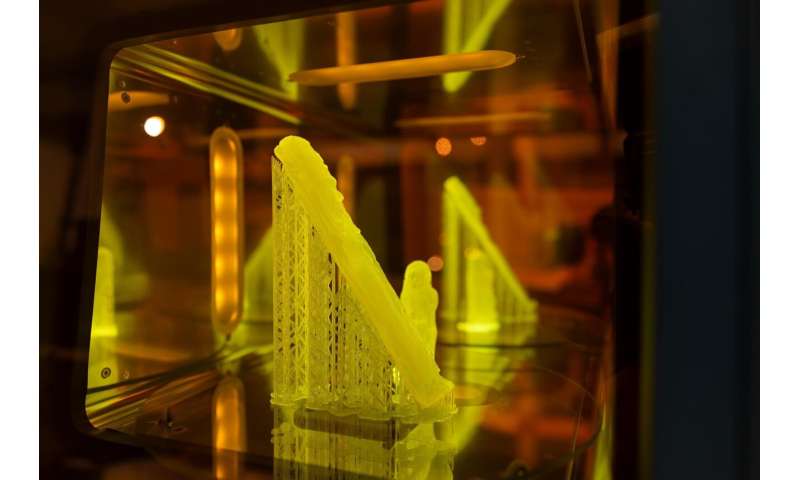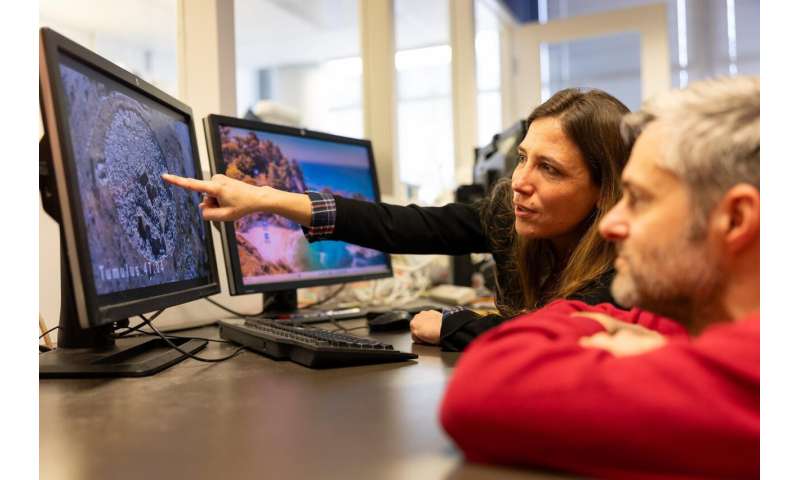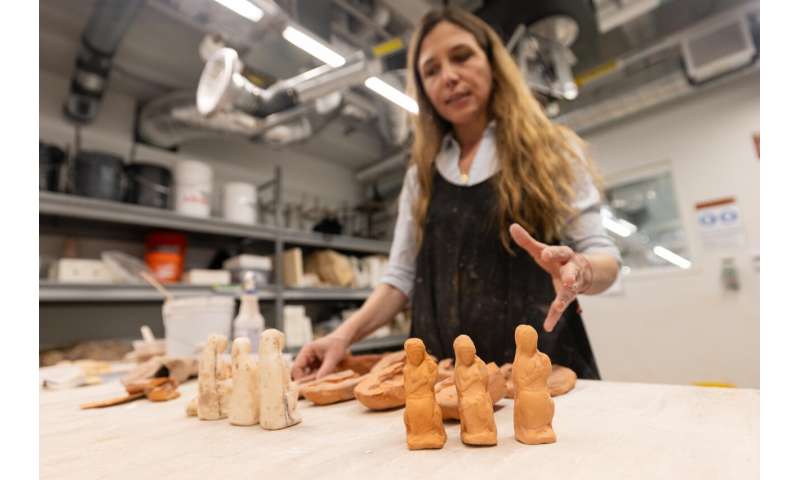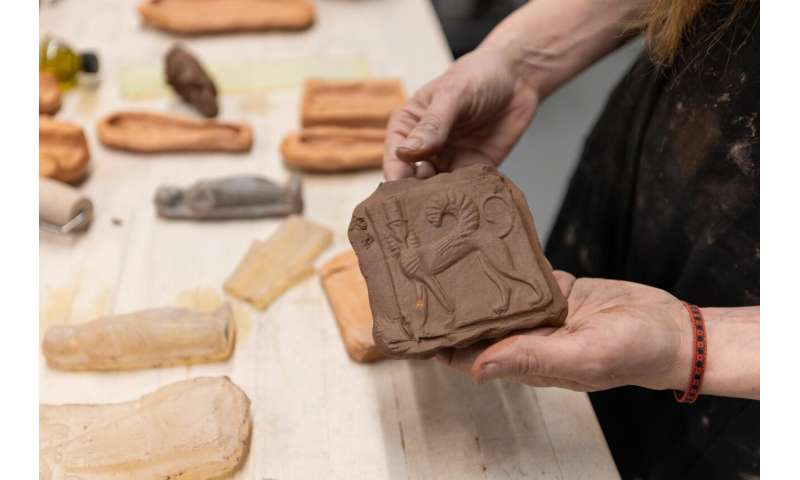Sure! Here’s a fresh, heartwarming retelling of the science story, tailored for a human audience:
In a captivating blend of ancient history and modern technology, a research team is unearthing secrets about the everyday lives of people from the Bronze Age. Led by the passionate Florence Gaignerot-Driessen at the University of Cincinnati, this project takes us on a journey through time, illuminating how creativity and ritual intertwined in ancient Greece.

At the archaeological site of Anavlochos on the stunning island of Crete, Florence and her team are delving into the remnants of ancient clay figurines and plaques. These artifacts, fondly referred to as “the ladies of Anavlochos”, offer a window into the lives and rituals of women from a bygone era.
Among the craggy hills and breathtaking vistas, the researchers have uncovered an array of female figures, some stored high in bedrock crevices. Each piece, whether intentionally broken or accident-prone, speaks volumes about its past. As Florence says, the climb to these heights is no small feat, but the views make every step worth it.
“The scenery is simply phenomenal,” she beams, gazing across the Mediterranean.
To piece together the story of these ancient reproductions, Gaignerot-Driessen blends traditional methodologies with cutting-edge technology. Utilizing modern resins alongside advanced 3D scanning and printing, she’s set out to recreate these ancient molds and figurines. Through this innovative approach, she aims to unravel the mysteries of mass production in ancient Greece.
Despite extensive digging, the workshop where these captivating ceramics were originally crafted remains elusive. Yet, the way they were placed among the rocks offers its own intriguing narrative. “These pieces were made without much finesse,” Florence explains. “Their value wasn’t in materials like gold or ivory. Instead, they were modest tokens of devotion, affordable for anyone seeking to connect with the divine.”
Collaborating with experts from the French National Center for Scientific Research, Florence and her team have brought these ancient figurines back to life. By crafting meticulous 3D models, they’ve harnessed UC’s Rapid Prototyping Center to reproduce these incredible artifacts while exploring the ancient methods used to create them.
-

Using resin reproductions of Bronze Age figurines, UC Assistant Professor Florence Gaignerot-Driessen will make clay molds to learn more about mass production processes in ancient Greece. Credit: Andrew Higley
-

The 3D-printed resin figurines turn bright green in machines that help cure the material. Credit: Andrew Higley
Exploring Ritual Significance
The ancient settlement at Anavlochos thrived between 1200 and 650 B.C., with the cherished figurines tracing back to 900 B.C. Though many were placed there after the settlement was abandoned, their purpose remains a tantalizing mystery.
Using sophisticated tools like photogrammetry and lasergrammetry, Florence and her colleagues have begun to visualize the layout of the pottery fragments, piecing together how they might have been placed into those rocky nooks.
Among their findings are plaques adorned with mythological depictions, including the iconic sphinx, and figurines illustrating women clad in period attire. “Their attire features elegant details, perfectly embodying femininity during the seventh century B.C.,” she notes.
The artwork discovered reflects the cultural exchange between Near Eastern and Greek civilizations, hinting at the journey of ideas across time and space.
While the exact rituals performed at Anavlochos remain conjectural, researchers consider various possibilities: perhaps these offerings marked significant transitions in life for women, symbolizing motherhood or maturity.
“We lack written records about these practices, but offering these figurines to a deity may have been a gesture of protection,” she reflects. “The participants could have been mothers praying for their daughters or young women seeking guidance.”
The project enjoys the support of the French School at Athens, alongside collaboration with the Greek Ministry of Culture and Sports.
-

University of Cincinnati Assistant Professor Florence Gaignerot-Driessen, left, consults with fabrication lab technician Jeffery Welch in UC’s Rapid Prototyping Center. Credit: Andrew Higley
-

University of Cincinnati Assistant Professor Florence Gaignerot-Driessen is using innovative methods to unlock the secrets of ancient mass production in Crete. She is working in UC’s Ceramics Lab to reproduce figurines like those she and her international archaeology team have uncovered in Crete. Credit: Andrew Higley
-

Assistant Professor Florence Gaignerot-Driessen makes clay plaques from molds in the University of Cincinnati’s Ceramics Lab. The plaque is a reproduction of a Bronze Age plaque found interred in crevices in bedrock at Anavlochos, Crete. It features an image of a sphinx. Credit: Andrew Higley
Reviving Ancient Techniques
Florence’s quest also seeks to determine whether the backs of certain figurines—depicting tender moments like a mother nursing her child—were crafted through molding or modeling techniques. The results could shed light on the advanced manufacturing methods of the time.
This year is particularly special, as Florence plans to take students to Crete to collaborate with specialists and immerse themselves in this extraordinary archaeological adventure. Together, they’ll experiment with local clays, creating new pieces and even testing their strength by deliberately breaking them, a method to understand their historical context.
“This embodies the essence of experimental archaeology,” she expresses enthusiastically. “We’re reconstructing ancient practices to learn about their lives.”
This collaboration with UC Classics has captured the imagination of many, including Nicholas Germann, the manager of UC’s Rapid Prototyping Center. He is thrilled about the intersection of ancient artistry and modern technology, noting how this project “recreates lost ceramic techniques while unveiling processes that help us understand degradation.”
In a world where past meets present, Gaignerot-Driessen’s work is not just unearthing artifacts; it’s reviving stories, bridging thousands of years to allow us a glimpse into the lives of women who once walked the paths of Anavlochos.
If you would like to see similar science posts like this, click here & share this article with your friends!

